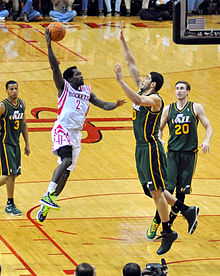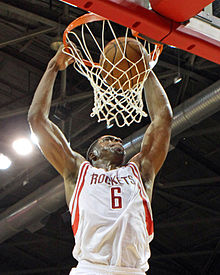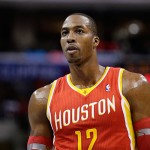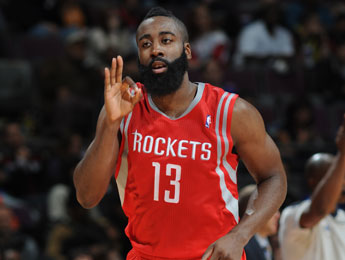 The 2014-15 Houston Rockets were a feel-good story, shaking off major injuries and muted preseason forecasts to become the Western Conference’s second-best team.
The 2014-15 Houston Rockets were a feel-good story, shaking off major injuries and muted preseason forecasts to become the Western Conference’s second-best team.
The 2015-16 Rockets, on the other hand, shouldn’t come as such a surprise. Following the bold offseason trade for former Denver point guard Ty Lawson, the story in Houston is back to being about what is, rather than what might be. In other words, GM Daryl Morey is finally “all-in” on his roster.
 While Lawson fills the obvious need of a second playmaker after James Harden, the rest of the offseason was focused on bringing back the core of the team that advanced to Houston’s first conference finals since 1997 after also finishing as the West’s No. 2 in the regular season (56-26). Point guard Pat Beverley and swingman Corey Brewer were re-signed to long-term deals. Heading into contract years, Donatas Motiejunas and Terrence Jones will each have the opportunity to return from injury and show why they should be the starting power forward alongside Dwight Howard.
While Lawson fills the obvious need of a second playmaker after James Harden, the rest of the offseason was focused on bringing back the core of the team that advanced to Houston’s first conference finals since 1997 after also finishing as the West’s No. 2 in the regular season (56-26). Point guard Pat Beverley and swingman Corey Brewer were re-signed to long-term deals. Heading into contract years, Donatas Motiejunas and Terrence Jones will each have the opportunity to return from injury and show why they should be the starting power forward alongside Dwight Howard.
Most notably, it’s clear that Morey likes the group he has in place and is betting on chemistry, continuity and depth more than in previous seasons. A year ago, only four players remained (Harden, Howard, Beverley, Jones) from the rotation of the 2013-14 playoff team that lost to Portland. Now, Morey is embracing his core of role players around Harden and Howard. The hope is that the benefits of continuity and better health could allow Houston to make the same type of leap forward in 2015-16 that Golden State did a season ago, all after a relatively uneventful offseason with player transactions.
In order for the Rockets to make that jump to the top of the West, though, several variables need to go their way. Here’s a look at the top five issues facing the team.
1. Who starts at point guard between Ty Lawson and Pat Beverley? Coach Kevin McHale has already said he will experiment with both players in the preseason.
 The case for Beverley is that he could be a better fit. His on-ball defense is superior to Lawson’s, and he doesn’t need the ball in his hands as much on offense. Those factors could make him mesh well with Harden, and the two already have almost two full seasons of experience starting next to each other. Plus, the energetic Lawson could be used as a bench spark plug, much like Manu Ginobili in San Antonio.
The case for Beverley is that he could be a better fit. His on-ball defense is superior to Lawson’s, and he doesn’t need the ball in his hands as much on offense. Those factors could make him mesh well with Harden, and the two already have almost two full seasons of experience starting next to each other. Plus, the energetic Lawson could be used as a bench spark plug, much like Manu Ginobili in San Antonio.
The case for Lawson is that he’s simply a better player. Assuming he is able to put his alcohol problems behind him, Lawson is potentially a top-10 point guard. Beverley is not. There’s a reason the Rockets have long sought another creator next to Harden, and it’s not just to anchor the bench unit when Harden rests. Rather, it’s also to reduce the workload on Harden when he is in the game and allow him to play more efficiently.
Of course, the player that starts the game won’t necessarily finish. Minutes can be staggered. But there are legitimate pluses and minuses to both scenarios, and it is up to McHale to determine quickly which gives the Rockets the best opportunity to win.
 2. Will a “power forward of the future” emerge? Advanced analytics love Jones, who plays well off the ball on both sides. He’s very efficient and has the athleticism to make plays in space. On the other hand, the “eye test” favors Motiejunas, whom McHale has lauded for having the best post offense on Houston’s team (including Howard). Motiejunas also moves the ball better and has steadily improved his 3-point shot, which is big given the Rockets’ need for floor-spacing alongside Howard.
2. Will a “power forward of the future” emerge? Advanced analytics love Jones, who plays well off the ball on both sides. He’s very efficient and has the athleticism to make plays in space. On the other hand, the “eye test” favors Motiejunas, whom McHale has lauded for having the best post offense on Houston’s team (including Howard). Motiejunas also moves the ball better and has steadily improved his 3-point shot, which is big given the Rockets’ need for floor-spacing alongside Howard.
Both are coming off serious injuries, though. Jones missed over half of last season with a nerve issue in his leg and a collapsed lung, and never seemed 100 percent when he returned for the playoffs. Motiejunas took on the heaviest workload of his career, but he missed the playoffs after undergoing back surgery in April. Both will also be motivated to put up numbers this season as each are due for new contracts – likely in the eight-figure range – following the season. Motiejunas may not be medically cleared to start camp, so Jones could have an opportunity to make the first impression.
Keep an eye on the rookies, too. McHale has already referenced potential for first-rounder Sam Dekker, a lanky forward out of Wisconsin who compares himself to Houston’s Trevor Ariza, to play minutes as a stretch-4 (as Ariza sometimes does). It also speaks volumes that Morey subjected the Rockets to a “hard cap” to sign second-rounder Montrezl Harrell to a three-year deal. Houston typically prioritizes flexibility for future moves, so Morey’s willingness to tie his own hands could be a huge vote of confidence in his rookie power forward out of Louisville.
3. In a contract year, has Howard put his injuries behind him? Howard signed his four-year deal in July 2013 with an opt-out after the third season. At the time, the logic was that the July 2016 opt-out could allow him to cash in immediately on the league’s new TV contract and rising player salaries.
 Now, it’s not as clear. A new contract may bring Howard upwards of $30 million per season, but the question is whether the Rockets (or any team) can responsibly make that investment. Howard had back problems dating to his time in Orlando and Los Angeles, and he missed half of last season with a knee condition that he described as “bone rubbing on bone” due to cartilage issues. Those are red flags.
Now, it’s not as clear. A new contract may bring Howard upwards of $30 million per season, but the question is whether the Rockets (or any team) can responsibly make that investment. Howard had back problems dating to his time in Orlando and Los Angeles, and he missed half of last season with a knee condition that he described as “bone rubbing on bone” due to cartilage issues. Those are red flags.
Nonetheless, Howard did return by the postseason and played very well throughout Houston’s run. Entering his 12th season, Howard is just 29 and a premier rim protector. There are plenty of reasons to still give Howard a max deal, but he needs to stay on the court more in 2015-16 to give Morey full confidence in building around him as Houston’s “second star” moving forward.
RELATED: Rockets salaries and analysis
4. Who are the odd men out in the wing rotation? The Rockets have more depth than they have had in a long time. Besides re-signing Brewer and drafting Dekker, they also brought back young defensive stud K.J. McDaniels and added a sharpshooter in Marcus Thornton.
Problem is, there are only 96 minutes per game at shooting guard and small forward. Pencil in Harden for at least 36 and Ariza for 30. That leaves only 30 for Brewer, McDaniels, Thornton and Dekker. Perhaps Ariza and Dekker open up a few more minutes by playing spot time at the 4, but the reality is the same – someone won’t have regular playing time, barring injuries.
Brewer’s time is likely secure after landing a $24 million contract, so the debate could be the importance of Thornton as a shooter (38 percent from three last season) and seasoned veteran vs. the defense, youth and athleticism of McDaniels.
5. How far can James Harden take them? The biggest reason the Rockets exceeded expectations was the evolution of their franchise player. Voted MVP by the players and runner-up by media, Harden was far better on defense while also becoming more efficient on offense (PER rose from 23.5 to 26.7) and boosting his numbers across the board, including a career-best 27.4 points per game. Although Houston had less talent and more injuries in 2014-15 than 2013-14, the team’s results were far better simply because of the improvement from Harden. That’s what a true franchise player can mean.
 Now, here’s the scary part for the rest of the NBA: Harden may be poised to get even better.
Now, here’s the scary part for the rest of the NBA: Harden may be poised to get even better.
If there’s one clear edge that Stephen Curry – the media’s MVP and eventual league champion – had over Harden, it was efficiency. It was reflected in the PER (28.1 to 26.7) and in Curry’s absence of high-turnover games, such as Harden’s record-breaking, 12-turnover performance in an elimination Game 5 of the West finals. But in fairness to Harden, part of the issue was personnel around them. Curry had Klay Thompson alongside him in Golden State’s backcourt, while Harden had a 37-year-old Jason Terry. It’s not a stretch to say that Harden faced significantly tougher defensive assignments.
Going forward, though? The shackles are off. In Lawson, Harden has the second guard he’s always wanted to relieve pressure and reduce the constant playmaking burden. Howard appears healthy again. The depth is better. Additionally, Harden is just 26 years old – nearly 18 months younger than Curry – and may have more room yet to grow. Curry didn’t peak until his age 26/27 season, and the same might be true with Harden.
As far as the 2015-16 Rockets are concerned, the bottom line is this: The inherent limitations that made them such a gritty overachiever a year ago are gone. The talent is now in place for Houston to make a serious run at a title. It’s time to see how far their franchise player can take them.
READ EVERY SEASON PREVIEW WITH OUR TEAM INDEX
Ben DuBose is a veteran sports reporter who has followed the Houston Rockets and the NBA since Hakeem Olajuwon was Akeem Olajuwon. He writes for both SheridanHoops and ClutchFans, an independent Rockets blog. You can follow him on Twitter.
For a more in-depth preview of the Rockets’ training camp battles, listen to Ben’s latest podcast.